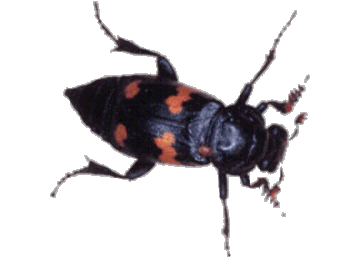What is Forensic Entomology?
|

|
Forensic Entomology is the use of the insects, and their arthropod
relatives that inhabit decomposing remains to aid legal investigations. The broad
field of forensic entomology is commonly broken down into three general areas:
medicolegal, urban, and stored product pests. The medicolegal section focuses on the
criminal component of the legal system and deals with the necrophagous (or carrion)
feeding insects that typically infest human remains. The urban aspect deals with the
insects that affect man and his immediate environment. This area has both criminal and
civil components as urban pests may feed on both the living and the dead. The damage
caused by their mandibles (or mouthparts) as they feed can produce markings and wounds on
the skin that may be misinterpreted as prior abuse. Urban pests are of great economic
importance and the forensic entomologist may become involved in civil proceedings over
monetary damages. Lastly, stored product insects are commonly found in foodstuffs
and the forensic entomologist may serve as an expert witness during both criminal and
civil proceedings involving food contamination.
How diverse is forensic entomology?
Here are a few examples: The diverse applications of forensic entomology
include the detection of abuse in children and neglect of the elderly. Published
cases exist that detail parents intentionally using wasps and bees to sting their children
as a form of punishment. Additionally, entomological evidence has been used to prove
neglect and lack of proper care for wounds existing on the elderly under both private and
institutional care.
It is theorized that the stings (or mere presence) of bees and wasps may be responsible
for a large number of single occupant car accidents that seem to lack a definitive cause.
Some accident studies have shown insects to be within the top 20 causes
of automobile accidents.
In addition to automobile accidents, insects have been suspected of causing
aircraft crashes through the obstruction of essential instrumentation, and even implicated
in the obstruction of fuel lines causing engine failure. Forensic entomologists are
also requested to examine the fragmented remains of insects that have impacted and lodged
on the front fascia, windshield, and radiator of automobiles. Analysis of such
remains can yield evidence to the probable path of an automobile through particular areas
when pinpointing the location and areas of travel are of unique importance.
Insects can also affect the interpretation of blood spatter pattern analysis.
Roaches simply walking through pooled and splattered blood will produce tracking that may
not be readily recognizable to the untrained observer. Specks of blood in unique and
unusual areas (such as on ceilings) may mislead crime scene technicians unless they are
aware of the appearance of blood contaminated roach tracks. Similarly, flies and
fleas may also track through pooled and spattered blood. However, flies will also
feed on the blood and then pass the partially digested blood in its feces, which are known
as "flyspecks". Flies will also regurgitate and possibly drop a blood
droplet on a remote surface, which may serve to confuse bloodstain analysis. Fleas
feeding on the living pass a large amount of undigested blood (used as the larval food
source) on many household surfaces. If a crime occurs in a heavily infected
apartment, fecal drops already present would serve to confuse analysts as those droplets
would test positive for human blood. Therefore it is important to recognize and
properly document the natural artifacts that may occur from the presence, feeding, and
defecation of roaches, flies, and fleas. Insects that feed on living, decomposing,
or dried vegetable material are submitted to the forensic entomologist in an effort to
determine the country or point of origin. This is particularly important with vegetative
material such as imported cannabis.
 |



